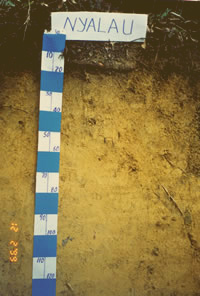Soil Profiles: Nyalau
Nyalau Series
The Nyalau Series is a member of the family of coarse loamy, siliceous, isohyperthermic, red-yellow to yellow Tipik Tualemkuts. It is developed over sedimentary rocks in which sandstones dominate. Soils of the Nyalau Series are characterized by their deep, well drained profiles with fine sandy loam textures. Colours range from brownish yellow to yellow. Structures are weak medium to fine subangular blocky and consistence is friable to 100 cm but gets firmer with depth. There is some problem in determining the diagnostic horizon. Mostly it is agreed that this soil has an argillic horizon but some believe that this soil has a cambic horizon. In this description here the soil is assumed to have an argillic horizon. These soils have a CECclay of less than 24 cmol (+) kg–1 soil in all subhorizons between 25 to 100 cm depth.
Type Location
Soils of the Nyalau Series were first described by Andriesse (1972) during the Reconnaissance Soil Survey of West Sarawak. The above pedon was described by Lim Chin Peng for the CLAMATROPS Tour II organised by the Malaysian Society of Soil Science in 1977 at the 24th milestone Bau-Lundu Road in West Sarawak. The pedon was located close to the crest of a 15° (30%) hill at an elevation of 110 m (³ 350 feet). The vegetation was a poor stand of Lowland Dipterocarp Forest merging into a ‘Kerangas’ forest. Location: Topographic Sheet 1/109/8, 1°33′ N, 109°54’30” E (Grif Reference 1/109/8 – 897705 m).
Range in Characteristics
Little is known about the range in characteristics of the Nyalau Series. They generally occur on rolling, hilly to steep terrain over sandstones and quartzites. Most of the soils described to-date are deep. Field textures are fine sandy loams and colours range from brownish yellow to yellow (10YR6/6–6/8 to 10YR7/6– 7/8, 8/6–8/8, 2.5Y7/6–7/8, 8/6–8/8). Structures are weak fine and medium subangular blocky and consistence is friable. Occasionally some organic coatings are present on ped faces. The cation exchange capacity values on the soil are low often less than 5 cmol (+) kg–1 soil. Base saturation values are very low. Soils of the Nyalau Series are redefined here as soils having a CECclay of less than 24 cmol (+) kg–1 clay in all subhorizons between 25 to 100 cm depth but has at least one subhorizon with a CECclay of > 16 cmol.
Competing Soils and Their Differences
Soils of the Nyalau Series are easily confused for other soils developed over sandstone material such as the Bekenu Series in Sawarak, the Malau and Serdang Series in Peninsular Malaysia and the Tanjong Lipat, Kapilit, Antulai and Laab Series in Sabah. The Bekenu, Serdang and Laab Series all have fine sandy clay loam textures while the Nyalau Series has fine sandy loam textures. The Antulai Series is often a moderately deep (50–100 cm) soil while the Nyalau Series is deep (> 100 cm). Both the Kapilit and Malau Series are reported to have clayskins. Differences in colour and CECclay values can be used to separate these soils. Both the Kapilit and Malau Series have a CECclay value of more than 24 cmol in at least some subhorizon between 25 to 100 cm depth.
Setting
Soils of the Nyalau Series typically occur on rolling, hilly to steep terrain (slopes in excess of 24% or 12°) at elevations in excess of 50 m (150 feet).
Principal Associated Soils
Soils of the Nyalau Series being developed over sandstones are commonly associated with soils of the Bekenu, Kapilit and Malau Series. As mentioned earlier these soils are separated using the clay content and their CECclay values.
Drainage and Permeability
Soils of the Nyalau Series are well drained. Permeability is good.
Use and Vegetation
Due to their sandy loam textures, the slopes on which they occur and their low fertility status, areas with the Nyalau Series are mostly under poor forests. Some areas however have been used for shifting cultivation, rubber, pepper, oil palm and fruit trees.
Distribution and Extent
To-date soils of the Nyalau Series have only been mapped in Sarawak. Their actual extent is not known.
Series Established
This soil was established by Andriesse (1972) during the reconnaissance soil survey of West Sarawak. The source of name is not known.
Remarks on Classification
The Nyalau Series is classified here according to the Malaysian Soil Taxonomy – Second Approximation (Paramananthan 1998) as a member of the coarse-loamy, siliceous, isohyperthermic, red-yellow to yellow family of Tipik Tualemkuts over sedimentary rocks. They are classified here as soils having a deep well drained argillic horizon with a low base saturation and a CECclay of 16 to 24 cmol (+) kg–1 clay. In the Keys to Soil Taxonomy – Eighth Edition (Soil Survey Staff 1998) this soil would probably be classified as Typic Paleudults since the soil has an argillic horizon, an udic moisture regime and a low base saturation. In the FAO/UNESCO Soil Map of the World – Revised Legend (FAO 1990) the Nyalau Series would probably be classified as Haplic Acrisols due to its argic horizon and low base saturation values.
Suitability for Agriculture
Due to their sandy loam textures, low fertility status, low water holding capacity and high erodibility soils of the Nyalau Series are best left under natural vegetation.



